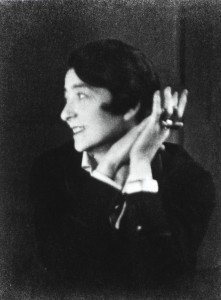When I came to write my novel The Interview, I felt I knew Eileen Gray. After all I had researched and written a previous book, Time & Destiny, a radio play for RTE, Time & Straw, several features and I’d given talks on her as far afield as Monaco. But I was wrong, I didn’t know her, still don’t, and that is part of her mystique.
The facts of her life are well documented. From the beginning it was the hidden, less publicised aspects that I found most intriguing. Because she had destroyed private papers, letters and photographs but left detailed accounts of each of her projects, I knew I had to be true to her work but I felt a strange entitlement to give her a happier personal life than she had experienced.
Throughout the pages of Time & Destiny she is unconditionally loved and desired by people I deemed worthy of her.
I loved the competent way she nurtured her talent, engaging Sugawara, the Japanese lacquerist to teach her the finer points of lacquering; refusing to follow the opulent trends of the time; and her working relationship with Jacques Doucet. I was amazed at her discreet but disastrous relationships with both men and women: her love affair with nightclub singer Damia and the destruction of her liaison with Romanian architect Jean Badovici. I was as saddened as Eileen at the re-furbishing of her family home, Brownswood (see photos below), and understood her refusal to return; outraged at the state of E.1027, the love nest she created for Jean Badovici.
I was fascinated by her elegant lifestyle in Paris and refusal to use her title; her wardrobe of designer clothes, handmade silk underwear, perfectly manicured nails and sharply bobbed hair. I admired her courage and ability to take on new ventures – driving an ambulance during the World War I; learning to fly; travelling the world. Despite her reclusiveness and failing eyesight, her selected interest in the world around her never diminished.
She had always been reluctant to give interviews and disliked being courted by the international media, as she had been from the early 1900s. In 1972 the record-breaking price paid for her lacquer screen Le Destin forced her back in the public eye. Reporters from all over the world clamoured for interviews, quotes and comments.
Long a fan of Bruce Chatwin’s writings, when I heard he’d been one of those reporters, I set about tracking down his interview with Eileen Gray. It wasn’t in any of his anthologies. Eventually I discovered from his wife, Elizabeth, that the interview had never been published.
My wondering what happened between the retiring designer who had become an international icon, second time around, and the charismatic maestro of interviews, was the trigger that drove me to write The Interview.
Eileen Gray Exhibition Pompidou Centre Paris, 2013
Brownswood image gallery
E.1027 image gallery


















